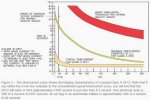cmckeehan
New User
- Location
- Fayetteville, Georgia 30214
- Occupation
- Building Inspector
In the 2017 edition of the NEC the definition of a GFCI includes, it should trip in the established time, what is the established time or where can I find it? Everything I read points to immediately or one-tenth of a second, however, I cannot find it in the code book.


